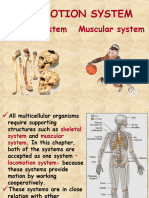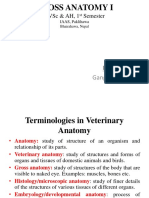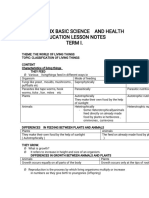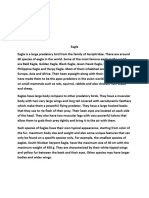Professional Documents
Culture Documents
Session 14 Skeletal System
Session 14 Skeletal System
Uploaded by
Science Of Life0 ratings0% found this document useful (0 votes)
15 views17 pagesThe skeletal system of fishes can be divided into the axial skeleton and appendicular skeleton. The axial skeleton includes the skull, vertebral column, and ribs, while the appendicular skeleton includes the pectoral and pelvic girdles and bones that support the fins. Specifically, the skull is made of dermal bone and endochondral bone, the vertebral column consists of vertebrae that surround the notochord, and the fins are supported by either spiny ossified rays or soft unossified rays attached to the pectoral or pelvic girdles.
Original Description:
Original Title
Session-14-Skeletal-System
Copyright
© © All Rights Reserved
Available Formats
PDF, TXT or read online from Scribd
Share this document
Did you find this document useful?
Is this content inappropriate?
Report this DocumentThe skeletal system of fishes can be divided into the axial skeleton and appendicular skeleton. The axial skeleton includes the skull, vertebral column, and ribs, while the appendicular skeleton includes the pectoral and pelvic girdles and bones that support the fins. Specifically, the skull is made of dermal bone and endochondral bone, the vertebral column consists of vertebrae that surround the notochord, and the fins are supported by either spiny ossified rays or soft unossified rays attached to the pectoral or pelvic girdles.
Copyright:
© All Rights Reserved
Available Formats
Download as PDF, TXT or read online from Scribd
Download as pdf or txt
0 ratings0% found this document useful (0 votes)
15 views17 pagesSession 14 Skeletal System
Session 14 Skeletal System
Uploaded by
Science Of LifeThe skeletal system of fishes can be divided into the axial skeleton and appendicular skeleton. The axial skeleton includes the skull, vertebral column, and ribs, while the appendicular skeleton includes the pectoral and pelvic girdles and bones that support the fins. Specifically, the skull is made of dermal bone and endochondral bone, the vertebral column consists of vertebrae that surround the notochord, and the fins are supported by either spiny ossified rays or soft unossified rays attached to the pectoral or pelvic girdles.
Copyright:
© All Rights Reserved
Available Formats
Download as PDF, TXT or read online from Scribd
Download as pdf or txt
You are on page 1of 17
Skeletal system of fishes
Dr. Amrutha Gopan
Assistant Professor
School of Fisheries
Centurion University of Technology and Management
Odisha
Einführung
There are two different skeletal types: the exoskeleton, which is
the stable outer shell of an organism, and the endoskeleton,
which forms the support structure inside the body.
The skeleton of the fish is made of either cartilage
(cartilaginous fishes) or bone (bony fishes).
Bone tissue is found only in the Subphylum Vertebrata.
As such, bone is often thought of as being typical of vertebrates.
In vertebrates, bone functions as a supporting tissue, a
calcium reserve and as a hemopoietic (blood forming)
tissue.
The skeleton is the basis of form and support of the vertebrate
body.
Muscles attach to the skeleton and vital organs are surrounded
• The main features of the fish, the fins, are bony fin
rays and, except for the caudal fin, have no direct
connection with the spine.
• They are supported only by the muscles.
• The ribs attach to the spine.
• Bones are rigid organs that form part of the
endoskeleton of vertebrates.
• They function to move, support, and protect the
various organs of the body, produce red and white
blood cells and store minerals.
• Bone tissue is a type of dense connective tissue.
• Bones come in a variety of shapes and have a
complex internal and external structure.
• They are lightweight, yet strong and hard, in addition
to fulfilling their many other functions.
The skeleton of vertebrates is
broadly divided into two parts:
the axial skeleton consisting of
the skull,
vertebrae and
ribs; and
the appendicular skeleton consisting of
the pectoral and pelvic girdles and
the bones of the appendages.
The Axial Skeleton
Skull
The skull of the perch is actually a double structure
consisting of two “boxes” of bone,
one enclosed by the other.
The outer skull is an armour of dermal bone.
Primitive extinct bony fish had dermal bony armour
covering most of their bodies.
In the modern fish, the outer skull is virtually all that
remains of this armour.
Dermal bone forms, as its name implies, in the dermis
of the skin and is not proceeded by a cartilage
structure.
The inner skull is composed of endochondral bone.
• Endochondral bone develops under the dermis and
replaces existing cartilaginous structures.
• Hence the name “endochondral” denotes the bony
tissue develops “within” existing cartilage
structures.
• Elements of the inner skull form the cranium or
brain case.
• The perch skull consists of many small bones.
Vertebral Column
A series of endochondral bones called vertebrae form the
vertebral column.
Vertebrae have several common features.
The large spool-shaped central portion of each is the centrum.
Extending through the middle of each centrum is a canal for the
passage of the notochord.
As mentioned previously, many fish retain a notochord throughout
life.
Above the centrum, an
arch of bone surrounds
and protects the spinal
cord.
A dorsal projection, the
neural spine, extends
outward from the
vertebral column.
The fish vertebral column
is divided into two
subdivisions: the trunk
and the tail (caudal).
Although fish do not have a
neck, the first two trunk
vertebrae are modified.
These vertebrae lack ribs.
The rest of the trunk
vertebrae possess ribs.
Caudal (tail) vertebrae
possess a ventral portion
which forms a hemal arch
which surrounds blood
vessels.
Appendicular Skeleton and Fins
Median Fins
The dorsal fins of the perch have fin rays for
support.
The anterior dorsal fin has ossified fin rays which
provide stiff support(spiny), while the fin rays of the
posterior dorsal fin are not ossified and are
flexible(soft).
Only the first two fin rays of the anal fin are ossified.
The caudal fin is composed entirely of soft, unossified
fin rays.
Pectoral Girdle and Fins
The pectoral fins are
attached to a bony girdle,
the pectoral girdle.
The pectoral girdle is
composed of a number of
fused elements.
The girdle is also fused to
the skull
(the head and trunk of the
perch move as a unit).
The fins are supported by
soft fin rays.
Pelvic Girdle and Fins
The pelvic fins are attached to the pelvic girdle, which is
composed of two bony pelvic plates.
The plates may be fused along the midline.
The pelvic girdle is not attached to the vertebral column nor to
the pectoral girdle, but is free-floating (embedded in muscle
only).
Only the medial fin rays are bony, the rest are the typical soft
unossified type.
Watch video on the following links
https://www.youtube.com/watch?v=9JtevualNp4
https://www.youtube.com/watch?v=-frsvjd7XEg
You might also like
- Animal Crossing Season Guide For FishDocument2 pagesAnimal Crossing Season Guide For FishKatie DeeNoch keine Bewertungen
- INTRODUCTION To Skeletal SystemDocument6 pagesINTRODUCTION To Skeletal SystemabuberkerabdullerhiiNoch keine Bewertungen
- Locomotiom & The Human Skeletal SystemDocument17 pagesLocomotiom & The Human Skeletal SystemNathanael MfumbaikaNoch keine Bewertungen
- Skeletal System of FishesDocument18 pagesSkeletal System of FishesYousaf AnwarNoch keine Bewertungen
- Tissue and Supporting SystemDocument15 pagesTissue and Supporting SystemjolaolumolusinNoch keine Bewertungen
- Topic 6 Skeletal SystemDocument8 pagesTopic 6 Skeletal SystemMary Ann Morillo TenederoNoch keine Bewertungen
- Skeleton: From Wikipedia, The Free EncyclopediaDocument11 pagesSkeleton: From Wikipedia, The Free Encyclopediacut amaliaNoch keine Bewertungen
- Lab Rep 4 FinalDocument21 pagesLab Rep 4 FinalBella LopezNoch keine Bewertungen
- 2nd Term Biology Ss1Document33 pages2nd Term Biology Ss1dasiakennethNoch keine Bewertungen
- Untitled PresentationDocument23 pagesUntitled PresentationSamia MustafaNoch keine Bewertungen
- Skeletal System Lesson PlanDocument10 pagesSkeletal System Lesson PlanNicketa AndersonNoch keine Bewertungen
- Locomotion SystemDocument151 pagesLocomotion Systemaynurwepayewa40Noch keine Bewertungen
- Skeletal System Lesson Plan 2Document12 pagesSkeletal System Lesson Plan 2Trudy- Ann CaineNoch keine Bewertungen
- The Skeletal SystemDocument19 pagesThe Skeletal SystemMatthew YoungNoch keine Bewertungen
- Classification, Physical Properties and Structure of BonesDocument7 pagesClassification, Physical Properties and Structure of Bonessimran kaurNoch keine Bewertungen
- Act08 The Skeletal System DiscussionDocument8 pagesAct08 The Skeletal System DiscussionSofia A.Noch keine Bewertungen
- PDS01A - Lesson 1Document30 pagesPDS01A - Lesson 1aresfenrirNoch keine Bewertungen
- Chapter 2Document35 pagesChapter 2Faiz ApaiNoch keine Bewertungen
- (Reading 3) The Skeletal SystemDocument18 pages(Reading 3) The Skeletal SystemTrúc Linh NguyễnNoch keine Bewertungen
- Skeletal System of VerteberatesDocument2 pagesSkeletal System of VerteberatesAfaqNoch keine Bewertungen
- Skeleton & LocomotionDocument10 pagesSkeleton & Locomotionali mtNoch keine Bewertungen
- Human Skeleton F3 NoradinDocument5 pagesHuman Skeleton F3 NoradinIbnu RaxaabNoch keine Bewertungen
- 2.1 (A) - Support & Locomotion in Humans & AnimalsDocument61 pages2.1 (A) - Support & Locomotion in Humans & Animalsliming8112Noch keine Bewertungen
- PP13 Human Skeletal System Tissues 1460451284Document65 pagesPP13 Human Skeletal System Tissues 1460451284angie432meNoch keine Bewertungen
- SkeletalsystemDocument43 pagesSkeletalsystemSamantha EllaineNoch keine Bewertungen
- Skeletal Systems in VertebratesDocument26 pagesSkeletal Systems in Vertebratesgoldennyeche080Noch keine Bewertungen
- Group2 - BSHM 1 BDocument43 pagesGroup2 - BSHM 1 BSAPILAN DENMARNoch keine Bewertungen
- Reading 3 The Skeletal SystemDocument18 pagesReading 3 The Skeletal Systemlephuongvy1406Noch keine Bewertungen
- Tocalo Sowaib PPT - 081105Document33 pagesTocalo Sowaib PPT - 081105Junaisah P. PangaponNoch keine Bewertungen
- 2.1 (A) - Support & Locomotion in Humans & AnimalsDocument59 pages2.1 (A) - Support & Locomotion in Humans & AnimalsilyNoch keine Bewertungen
- Anatomy and Physiology Module 8aDocument11 pagesAnatomy and Physiology Module 8aJayR MendonesNoch keine Bewertungen
- Bone AnatomyDocument11 pagesBone AnatomyLiam Jacque LapuzNoch keine Bewertungen
- UntitledDocument7 pagesUntitledNafee BouzaidNoch keine Bewertungen
- Anatomy and Physiology of Farm AnimalsDocument157 pagesAnatomy and Physiology of Farm AnimalsOliver Talip100% (1)
- Skeletal System (2) - 2Document71 pagesSkeletal System (2) - 2alazarademe797Noch keine Bewertungen
- ZLY 106 The Vertebrate SkeletonDocument21 pagesZLY 106 The Vertebrate SkeletonOyeleke AbdulmalikNoch keine Bewertungen
- Vertebrate Systems SummaryDocument29 pagesVertebrate Systems SummaryHazel Grace Bellen100% (1)
- Skeletal SystemDocument5 pagesSkeletal SystemArra BeatrizNoch keine Bewertungen
- Bone and CartilageDocument61 pagesBone and CartilageMohamed AtefNoch keine Bewertungen
- Skeletal SystemDocument8 pagesSkeletal SystemJules ConcepcionNoch keine Bewertungen
- Body Support and MovementDocument18 pagesBody Support and Movementsokrispy09Noch keine Bewertungen
- Scheme of Work For Biology Ss1 Third TermDocument28 pagesScheme of Work For Biology Ss1 Third TermSamuel OlugbemiNoch keine Bewertungen
- IAAS 1st Sem 2 PDFDocument274 pagesIAAS 1st Sem 2 PDFNadim KhadkaNoch keine Bewertungen
- Chapter 4 Hap Complete Notes by Noteskarts Acc To ER20Document14 pagesChapter 4 Hap Complete Notes by Noteskarts Acc To ER20RDX failureNoch keine Bewertungen
- MovementDocument12 pagesMovement2hkvpgtt9dNoch keine Bewertungen
- 2ND Term S2 Biology-1Document38 pages2ND Term S2 Biology-1Faith OpadeleNoch keine Bewertungen
- Exercise 6 Musculo SkeletalDocument9 pagesExercise 6 Musculo SkeletalJacob NoraNoch keine Bewertungen
- THE SKELETAL SY-WPS OfficeDocument4 pagesTHE SKELETAL SY-WPS OfficeFollero AlyanaNoch keine Bewertungen
- Movement 2024Document14 pagesMovement 2024HannahNoch keine Bewertungen
- Anaphs 200 Lec. NoteDocument40 pagesAnaphs 200 Lec. Notesadiq rabiu umarNoch keine Bewertungen
- Chapter 6 - BoneDocument17 pagesChapter 6 - Bonebussniesm05Noch keine Bewertungen
- Bio 342Document76 pagesBio 342Steph VeeNoch keine Bewertungen
- Anatomy and Physiology of Farm AnimalsDocument157 pagesAnatomy and Physiology of Farm AnimalsOliver TalipNoch keine Bewertungen
- Veterinary OsteologyDocument279 pagesVeterinary OsteologyTatenda Mageja100% (2)
- 20201012-20201019-1149-Skeletal SystemDocument61 pages20201012-20201019-1149-Skeletal Systemdrin zekaNoch keine Bewertungen
- $R4UVS5TDocument32 pages$R4UVS5Tnechtech6Noch keine Bewertungen
- Sekolah Berasrama Penuh Integrasi Gopeng Prepared By:Muhd Fazli Bin DollahDocument60 pagesSekolah Berasrama Penuh Integrasi Gopeng Prepared By:Muhd Fazli Bin DollahrameshkasinathanNoch keine Bewertungen
- Bones in The Body 1. Skull: Skeletal SystemDocument12 pagesBones in The Body 1. Skull: Skeletal SystemSolemnly SwearrNoch keine Bewertungen
- HSB Week 13Document19 pagesHSB Week 13edhanassarNoch keine Bewertungen
- Unit 2-4 Anatomy and Human Physiology NotesDocument90 pagesUnit 2-4 Anatomy and Human Physiology NotesAbi .JNoch keine Bewertungen
- The History of GeomorphologyDocument19 pagesThe History of GeomorphologyScience Of Life100% (1)
- Biodeg&bioremedDocument69 pagesBiodeg&bioremedScience Of LifeNoch keine Bewertungen
- Iotrickling Ilters: ApplicationsDocument2 pagesIotrickling Ilters: ApplicationsScience Of LifeNoch keine Bewertungen
- BiodiversityDocument8 pagesBiodiversityScience Of LifeNoch keine Bewertungen
- The Story About SnappersDocument9 pagesThe Story About SnappersZulfahri HalomoanNoch keine Bewertungen
- Analisis Relevansi Materi Superkelas Pisces Dalam Aspek Penerapan Ilmu Taksonomi Hewan Di SekolahDocument12 pagesAnalisis Relevansi Materi Superkelas Pisces Dalam Aspek Penerapan Ilmu Taksonomi Hewan Di Sekolahdwi muharromiNoch keine Bewertungen
- Technical Supplement14-Fish Passage and Screening DesignDocument56 pagesTechnical Supplement14-Fish Passage and Screening Designஅம்ரு சாந்திவேலுNoch keine Bewertungen
- Marine Fish For Beginners EbookDocument12 pagesMarine Fish For Beginners Ebookpule rikyNoch keine Bewertungen
- Amazing Facts: Blue WhaleDocument6 pagesAmazing Facts: Blue WhaleGiudi RosatoNoch keine Bewertungen
- A Vertebrate Is An Animal With A Spinal Cord Surrounded by Cartilage or Bone. It Includes Fish, Amphibians, Reptiles, Birds, and MammalsDocument7 pagesA Vertebrate Is An Animal With A Spinal Cord Surrounded by Cartilage or Bone. It Includes Fish, Amphibians, Reptiles, Birds, and Mammalska travelNoch keine Bewertungen
- Shark: Deandy Farrell Rafaiz Hendri Chaeri SaputraDocument10 pagesShark: Deandy Farrell Rafaiz Hendri Chaeri SaputraDeandy FRNoch keine Bewertungen
- For Demo (Verterbrate)Document36 pagesFor Demo (Verterbrate)judyannmaranancortez0927Noch keine Bewertungen
- Song I've Got A RabbitDocument2 pagesSong I've Got A RabbitLady RakkelNoch keine Bewertungen
- Dalyan 2014Document2 pagesDalyan 2014Fadhli LatuconsinaNoch keine Bewertungen
- (Compana) 1 - Long ExamDocument25 pages(Compana) 1 - Long Examskyepod01Noch keine Bewertungen
- P6 Science Lesson Notes All TermsDocument137 pagesP6 Science Lesson Notes All TermsNassseremba masitulaNoch keine Bewertungen
- Day 2 - AdjectivesDocument83 pagesDay 2 - AdjectivesHasan NashrullahNoch keine Bewertungen
- Escola Professora Eutália de Oliveira SantosDocument2 pagesEscola Professora Eutália de Oliveira Santosalvaro santosNoch keine Bewertungen
- Rohu - WikipediaDocument6 pagesRohu - WikipediaAmitesh TejaswiNoch keine Bewertungen
- E Book BirdsDocument57 pagesE Book Birdsbirdbird214109Noch keine Bewertungen
- Animals Names, Animals and Their Young Ones: 2 Years AgoDocument11 pagesAnimals Names, Animals and Their Young Ones: 2 Years AgoJosh AyeleNoch keine Bewertungen
- Eyes Head Beak FeathersDocument10 pagesEyes Head Beak FeathersLeimar PadreNoch keine Bewertungen
- Birds DictionaryDocument11 pagesBirds DictionaryImran Khan0% (1)
- Eagle Report TextDocument2 pagesEagle Report TextJihanlalaNoch keine Bewertungen
- Extra Photocopiable Material 1 Final Assessment: Unit 1 Unit 4Document2 pagesExtra Photocopiable Material 1 Final Assessment: Unit 1 Unit 4Constanza Rojas BurgosNoch keine Bewertungen
- 1597 - Fish Identification by Saha Dev JakharDocument60 pages1597 - Fish Identification by Saha Dev JakharMahin FatimaNoch keine Bewertungen
- DAILY LESSON PLAN Science 6Document6 pagesDAILY LESSON PLAN Science 6judyannmaranancortez0927100% (1)
- Animales ListaDocument6 pagesAnimales ListaRsj Judith Ch-mNoch keine Bewertungen
- Amazon Jungle ComprehensionDocument5 pagesAmazon Jungle Comprehensioncontactahmed1211Noch keine Bewertungen
- Identifikasi Ikan Karang - Alan Zikirramadlan - 1910716210012Document53 pagesIdentifikasi Ikan Karang - Alan Zikirramadlan - 1910716210012ALAN ZIKIRRAMADLANNoch keine Bewertungen
- Ingles S.D.VDocument8 pagesIngles S.D.VDaniel LimaNoch keine Bewertungen
- Florida Recreational Saltwater Fishing Regulations: Reef FishDocument4 pagesFlorida Recreational Saltwater Fishing Regulations: Reef FishJames ReiterNoch keine Bewertungen
- Dr. MonkeyDocument5 pagesDr. MonkeyEster MarfàNoch keine Bewertungen





























































































